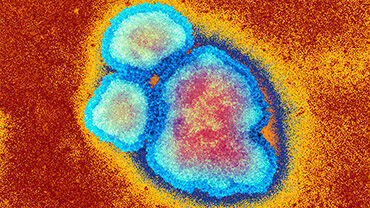Epidemiological update: Measles - monitoring European outbreaks, 6 April 2017
In Europe, measles cases have been reported in Austria, Belgium, Bulgaria, Denmark, France, Germany, Hungary, Iceland, Italy, Portugal, Spain and Sweden as well as in Romania, where 4 025 cases have been reported as of 31 March 2017.
A measles outbreak in Romania has been ongoing since February 2016 and cases continue to be reported despite ongoingresponse measures that have been implemented at national level through reinforced vaccination activities. Between September 2016 to 31 March 2017, Romania reported 4 025 cases.In 2016, a number of EU/EEA countries reported measles outbreaks, and an increase in the number of cases continues to beobserved in 2017. Some of the previous and ongoing measles outbreaks in other EU countries have been epidemiologically linked to the current outbreak in Romania. However, additional knowledge (e.g. genotypic characterisation of the virus) is needed to carry out a successful epidemiological investigation.
Weekly summary
In Europe, measles cases have been reported in Austria, Belgium, Bulgaria, Denmark, France, Germany, Hungary, Iceland, Italy, Portugal, Spain and Sweden as well as in Romania, where 4 025 cases have been reported as of 31 March 2017.
Epidemiological summary
Austria: Since the beginning of 2017 and as of 6 April, Austria reported 72 cases of measles, which exceeds the cumulative number of cases reported in 2016.
Belgium: Since 20 December 2016 and as of 31 March 2017, Wallonia reported 266 measles cases. The outbreak affects all provinces of Wallonia, with the exception of the province of Luxembourg. All age groups are affected and 53% of cases are over 15 years. Most of the cases were not vaccinated or did not know their vaccination status. Nearly 40% were hospitalised. No deaths have been reported. The same genotype, B3, similar to the strain found in Romania, Italy and Austria at the end of 2016, has been identified. The index case of the epidemic travelled to Romania during incubation period. In Flanders, one isolated imported case was reported in January and another one in March, with possible links to a cluster in Wallonia. In the Brussels Capital Region, one isolated imported case was reported in February and two cases were notified in March without known links to the epidemic in Wallonia. Both imported cases had a travel history to Romania during incubation period, and the national reference centre for measles, mumps and rubella (WIV-ISP) identified genotype B3, which is the same strain found in Romania, Italy and Austria at the end of 2016.
Bulgaria: Since mid-March 2017 and as of 7 April 2017, Bulgaria reported 30 cases of measles in the city of Plovdiv. This is an increase of 21 cases since the last report.
Denmark: On 15 March 2017, Denmark reported an imported case of measles in an unvaccinated adult who was infected during holidays in Asia.
France: Since the beginning of 2017, France has reported measles cases in several departments. As of 28 February 2017, France reported 79 cases, mainly related to an outbreak in Lorraine with more than 50 cases until end of February. Two cases had encephalitis and seven severe pneumonia. The virus is circulating in several departments and Moselle and Meurthe-et-Moselle are currently the most affected areas, with 61 cases as of 13 March 2017.
Germany: According to the national public health institute, since the beginning of 2017 and as of 12 March 2017, Germany reported 272 cases, an increase by 37 cases compared with the previous update. In the same period in 2016, Germany reported 18 cases. According to the media, Duisburg reported 165 cases since the beginning of the year and as of 31 March.
Hungary: Between 21 February 2017 and 8 March 2017, Hungary reported 13 cases of measles among healthcare workers. Media reports 41 cases compatible with measles as of 13 March.
Iceland: On 31 March, Iceland reported two cases of measles in two 10-month-old unvaccinated twin siblings. The first case was diagnosed 10 days before the second case. This is the first time in about quarter of a century that measles infection has occurred in Iceland.
Italy: Since the beginning of 2017 and as of 4 April 2017, Italy reported 1 333 cases of measles, with 131 cases among healthcare workers. The cases are reported from 19 of the 21 regions in Italy. A majority of the cases (93%) are from Piedmont, Lazio, Lombardy, Tuscany, Abruzzi and Sicily. Most of the cases are above 15 years and 88% of the cases were not vaccinated.
Portugal: On 31 March, Portugal reported one imported case from Venezuela and another unrelated case, an 11-month-old baby, most likely infected by a family member living in another EU country, visiting Portugal. Following these cases, on 7 April Portugal reported three additional cases.
Romania: Between 1 January 2016 and 31 March 2017, Romania reported 4 025 cases of measles, including 18 deaths. Cases are either laboratory-confirmed or have an epidemiological link to a laboratory-confirmed case. Infants and young children are the most affected population. In Romania 37 of the 42 districts report cases. The most affected is Caras Severin in the west part of the country, at the border with Serbia, with 854 cases. Vaccination activities are ongoing in order to cover communities with suboptimal vaccination coverage.
Spain: An outbreak started in the first week of January due to an imported measles case from China. As of 10 March, Barcelona and its metropolitan area reported 35 confirmed cases of measles. The cases are mostly adults who were either incompletely vaccinated or unvaccinated. Two of the cases are children, and six cases were hospitalised. A first case in three years was detected on the Canary Islands in a tourist.
Sweden: Since the beginning of 2017 and as of 21 March 2017, Sweden reported 15 cases of measles, including three imported cases.
Switzerland: Since the beginning of 2017 and as of 21 March 2017, Switzerland reported 52 cases of measles. In February 2017, a vaccinated man died of measles in Switzerland. He was undergoing strong immunosuppressive treatment for leukaemia, which explains why the measles vaccination did not protect him. This is the first measles death in Switzerland since 2009.
ECDC assessment
Measles outbreaks continue to occur in EU/EEA countries, and there is the risk of spread and sustained transmission in areas with susceptible populations. The national vaccination coverage remains less than 95% for the second dose of MMR in the majority of EU/EEA countries. The progress towards elimination of measles in the WHO European Region is assessed by The European Regional Verification Commission for Measles and Rubella Elimination (RVC). Member States of the WHO European Region are making steady progress towards the elimination of measles. At the fifth meeting of the RVC for Measles and Rubella in October 2016, of 53 countries in the WHO European Region, 24 (15 of which are in EU/EEA) were declared to have reached the elimination goal for measles, and an additional 13 countries (nine in the EU/EEA) were concluded to have interrupted endemic transmission for between 12 and 36 months, meaning they are on their way to achieving the elimination goal. However, six EU/EEA countries were judged to still have endemic transmission of measles: Belgium, France, Germany, Italy, Poland and Romania.
Source: WHO - Europe
Actions ECDC has prepared a Rapid Risk Assessment published on 6 March 2017. ECDC monitors measles transmission and outbreaks in the EU/EEA on weekly basis through enhanced surveillance and epidemic intelligence activities.







